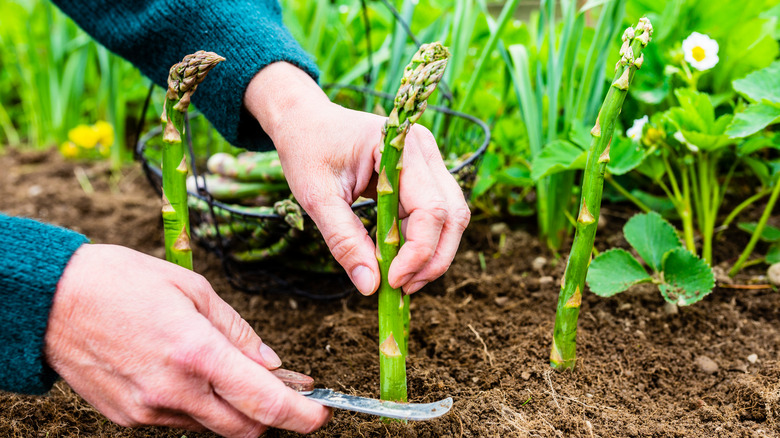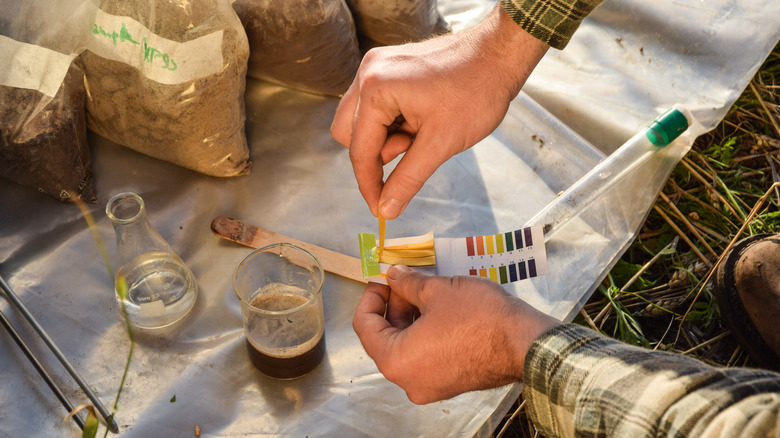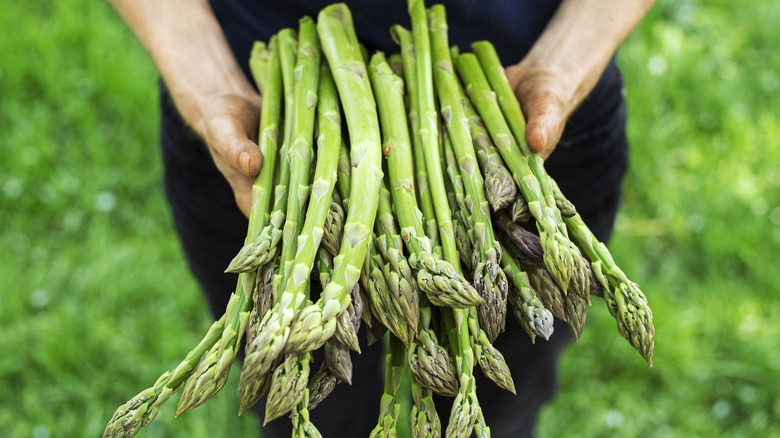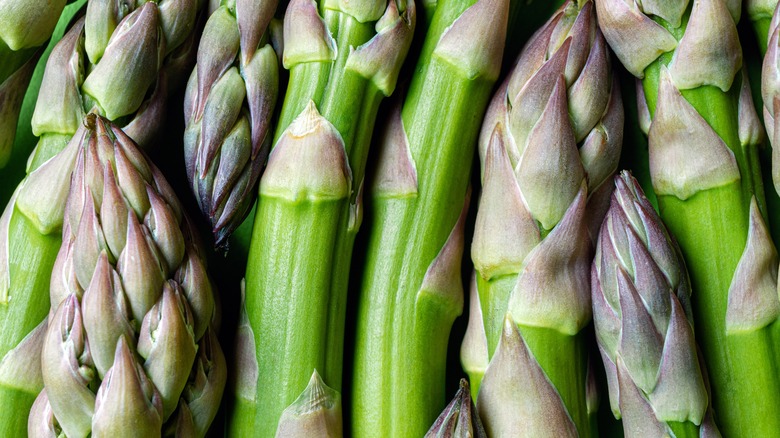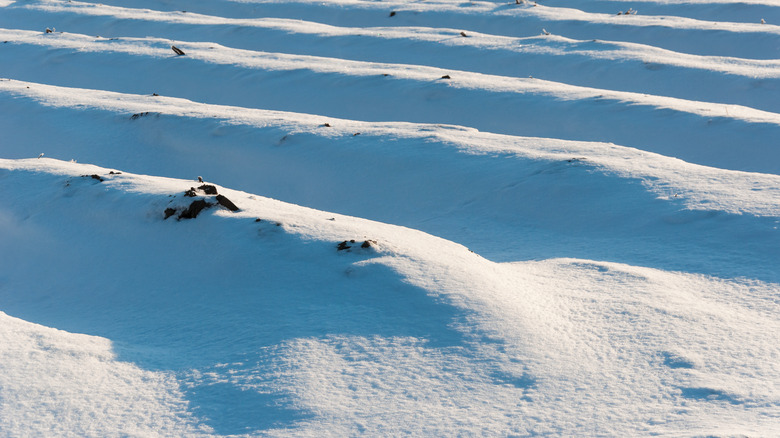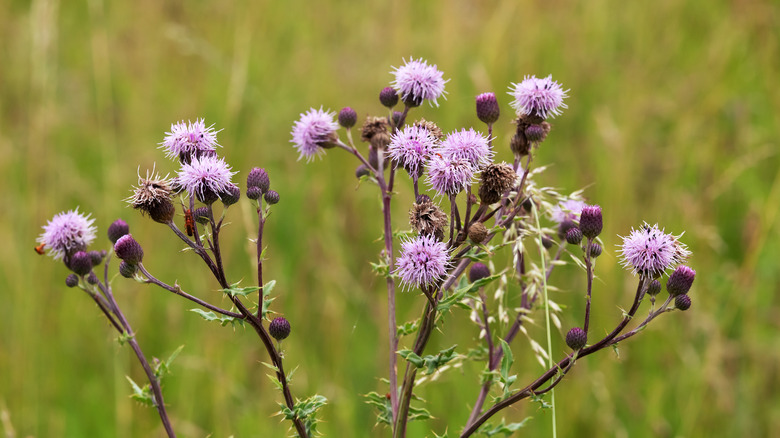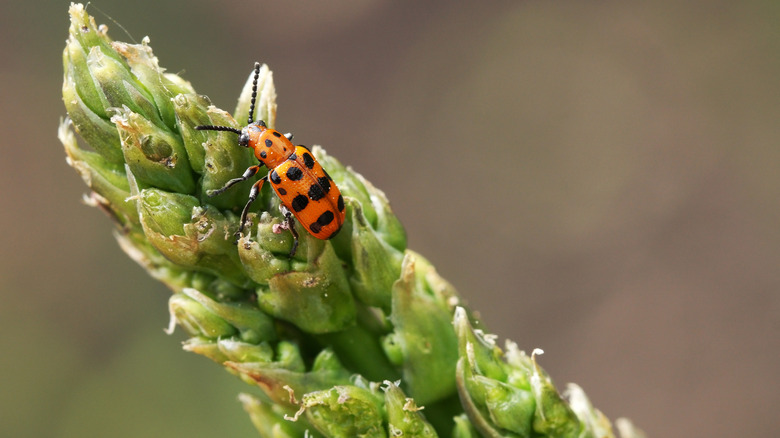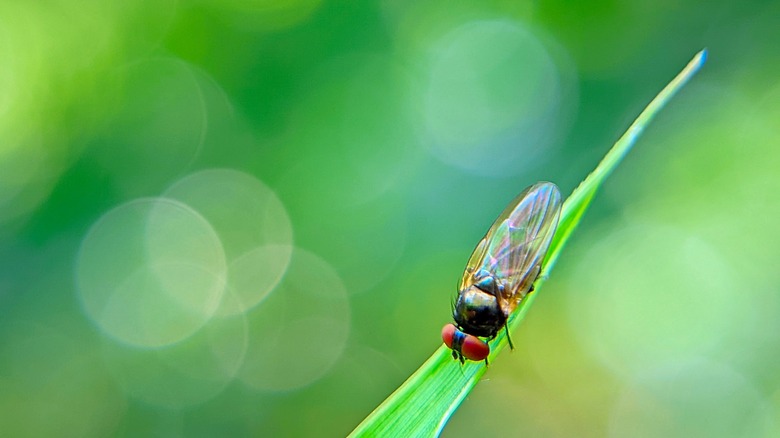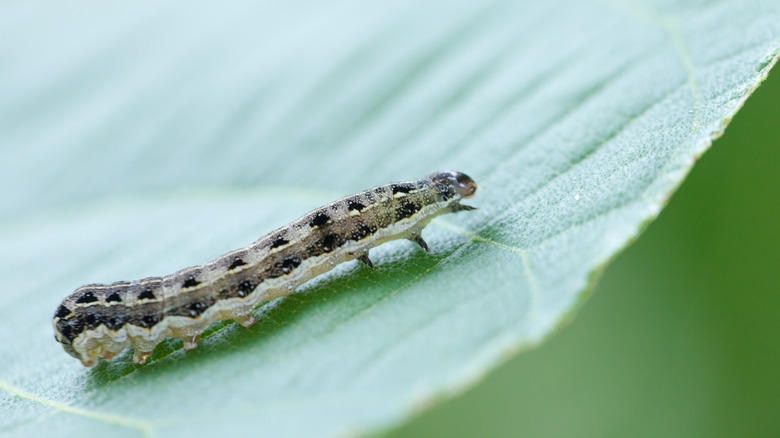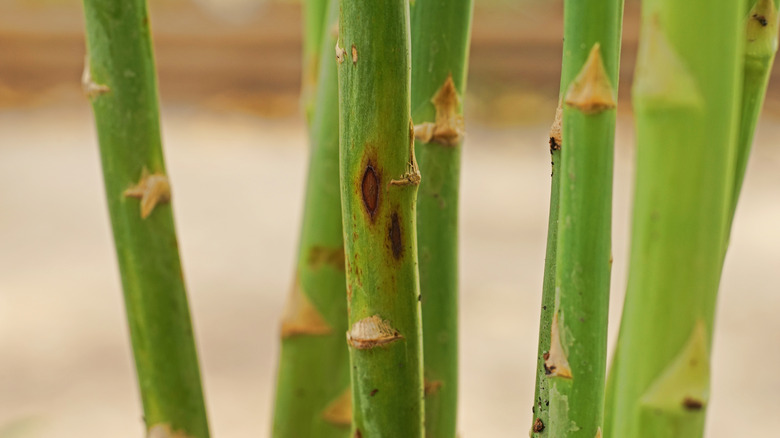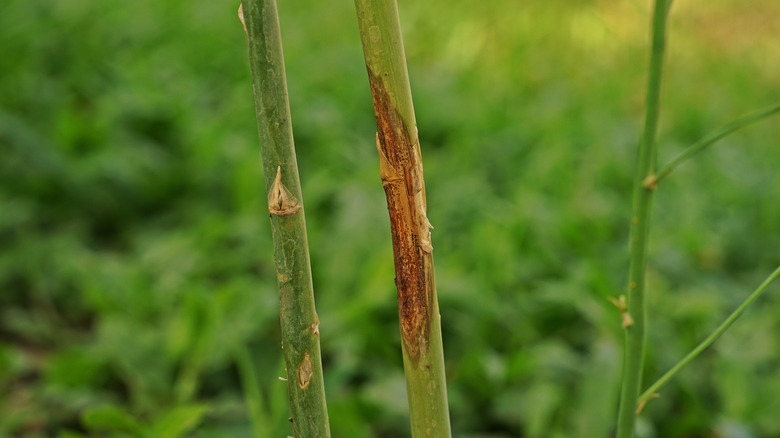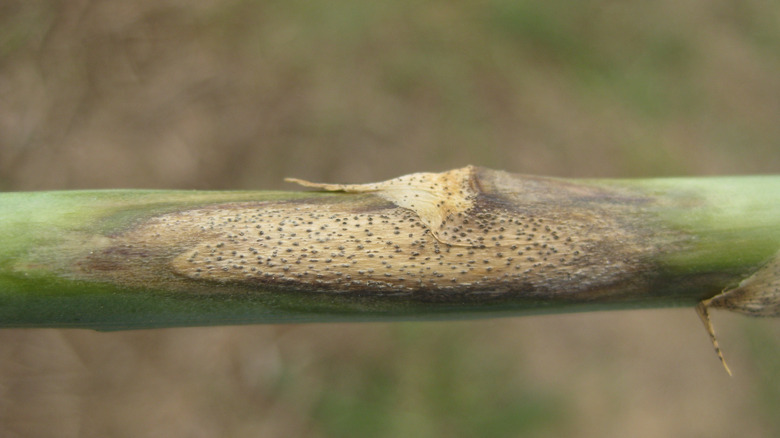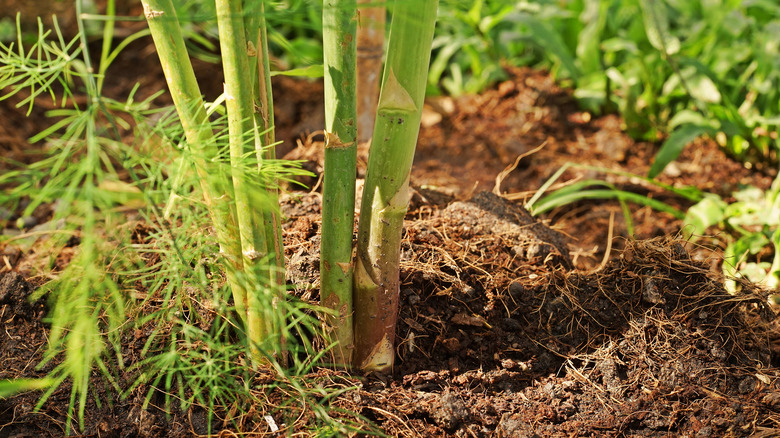Common Issues You Should Know About Before Growing Asparagus
The perennial asparagus is an excellent vegetable to add to your garden. The plant stays productive for well over 15 years in the right conditions, and it can serve as an ornamental with its ferny and colorful shoots. But unlike other vegetables, getting it to establish in the soil can be challenging. In fact, asparagus is one of the most difficult vegetables to grow in your garden. For all its longevity and productivity, the veggie requires specific growing and care conditions before and after planting, and throughout its long years. And once it's growing successfully in the garden, you need to watch out for the pests who, just like you, find its spears extra delicious.
Asparagus diseases are another hurdle that could diminish your harvest or, worse, end the plant's life prematurely. There are several of those infections and you'll have to identify them and take precautions or look out for the early symptoms and act quickly to save your plants. This might all seem intimidating, especially if this is your first time growing the crispy veggie. But there's no need to feel discouraged. This article sheds light on the common issues you might come across when growing asparagus, as well as how to fix or prevent them before they even happen.
It requires proper soil testing and preparation
Without the right soil quality, pH levels, and nutritional values, asparagus will struggle to grow in your garden and might not establish at all. Whether you have loamy or sandy soil, the most crucial factor is that it drains well. Water-logged soil can be detrimental to the plant and lead to diseases such as root and crown rot. The plant also doesn't favor acidic soil and pH levels should be maintained around 6.5 to 7.0 throughout its life. Nutrition deficiency is another issue to look out for before you plant your asparagus in the bed. The absence of necessary nutrients can lead to stunted growth and tough and chewy spears.
To avoid all those pitfalls and to give your asparagus a good start, you need to test the soil beforehand. It's better that testing be performed by professionals, so sending a soil sample to your local agriculture department is recommended. Keep in mind that these tests should be done regularly once every three years. Once you have the test results, you can amend the soil accordingly. Adding organic material, compost, and manure improves its draining. To adjust acidic soil, add lime to increase its pH levels. Asparagus also needs 1.2 pounds of a balanced fertilizer for every 100 square feet of soil.
Harvesting has to be timed right and in the correct quantities
Harvesting asparagus is another aspect of the plant that is fraught with problems. Since the spears are literally the young stalks that turn into ferns and support the crown, the risk of overharvesting is high. Overharvesting not only impacts the vegetable's growth, but also reduces the harvest over the next season. Another problem has to do with harvesting too early. If you don't allow the plant to fully develop first, cutting those delicious spears could lead to depleted sugar reserves in the plant, which affects its quality and leaves it vulnerable to pests and diseases.
To prevent these problems, you should allow your asparagus enough time to establish before you begin harvesting the spears. This depends on how you started your plants. For asparagus grown from seeds, the recommended time to start harvesting is after three years. If you started it from crowns, then harvesting can begin in the second year. The first harvest season should be limited to just two to three weeks to protect the plants. In the spring, cut the spears when they're between 6 to 8 inches long. A healthy plant will replace the cut spears with thick new ones. But after six to seven weeks of harvesting, the new spears grow as thin as a pencil or less. That's your cue to end the harvesting season.
Planting all-female asparagus varieties is not to your advantage
Another peculiar aspect of asparagus is that it's a dioecious vegetable. That means that the plant can be either male or female. This not only makes pollination a little complicated, but it has a huge effect on the size of the spears you harvest and the abundance of the annual yield as well. After pollination, female asparagus will produce berries. These berries are not just inedible, but they take up a lot of plant resources to develop. This is why female asparagus plants have a lower yield on average than male plants. Moreover, a male asparagus produces smaller, but more uniform, spears than their female counterparts. If you plant all-female varieties, you would have larger, but fewer, spears overall. Also, you will have to deal with the asparagus seedlings that grow like weeds around the female plants.
One way to avoid this issue is to select varieties and hybrids that are all male. One of the popular all-male asparagus hybrids to consider is the Jersey series. It was developed by Rutgers University and includes Jersey Giant, Jersey Supreme, and Jersey Knight. Millennium is another new cold-hardy hybrid with high yield.
Winter care is essential for its survival and productivity
Winter isn't kind to many perennials, and asparagus is no exception. Cold weather could damage the roots and cause the stalks to turn soft and brown. Asparagus is susceptible to damage when the temperatures drop to the low-20 degrees Fahrenheit. In warm climates where the winter is mild throughout, wintering the vegetable isn't necessary. But if you live in a cold region where frost is a regular threat, then you need to prepare your asparagus bed for the coming winter.
You can start wintering the asparagus when the leaves turn yellow and fall off in autumn. Cut back the fronds to about 2 or 3 inches from the ground. The next step is to cover the bed with a thick layer of organic mulch, such as sawdust, wood chips, or straw. Usually, 4 to 6 inches of mulch will protect the plant against cracking when unpredictable weather causes the soil to freeze again after thawing. Keep in mind that mulching could slow the growth of the asparagus in the spring. So, if you get a thick snow covering in the winter, you don't need to mulch the beds. After the last frost, inspect the plant and remove any stalks damaged by the cold.
Weeds are a major threat
Because asparagus is a perennial that lives for many years, you might neglect to till the soil and leave the bed undisturbed. This encourages weeds, such as quackgrass and Canada thistle, to grow and compete with the vegetable. Both annual and perennial broadleaf and grass such as ragweed, wild radish, and nutsedge also take root in the uncultivated bed. These weeds often consume a lot of the nutrients and moisture in the soil, which impacts the growth and productivity of the asparagus. Some tall weeds could also throw a shadow over the vegetables and cut sunlight.
The best way to deal with weeds in a small asparagus bed is to pull them out by hand. When the soil is soft after watering, put your hand around the base of the weed and give it a good tug. Make sure the plant comes out with its roots. Shallow tilling of the soil that turns the top 3 inches of the rows can also prevent many weeds from establishing in the bed. The best times to till the soil are in the early spring before the first spears grow, and again in the fall after the harvest season. Mulching and herbicides are good options to fight off the weeds.
Watch out for these three beetles
Beetles love asparagus so much that three species target its spears relentlessly and two of them are named after the vegetable. Those two are the common asparagus beetle and the spotted asparagus beetle. They both have a quarter-inch-long, oval-shaped body with two antennae. However, the common beetle has a dark blue body with cream blotches, while the spotted beetle has a reddish-orange body with 12 black spots. Both the larvae and adult common asparagus beetles feed on the ferns of the plant. Meanwhile, the larvae of the spotted beetle feed on the berries, while the adults feed on the buds and young spears. The third beetle is the Japanese beetle. It's a flamboyant bug, about 1/3 of an inch long, with a bright green head and bronze wings. It feeds on and strips off the leaf-like parts of the stem.
One way to manage the two asparagus beetles is to pick them up by hand and drown them in a bucket full of soapy water. They're most active in the afternoons, so that's the best time to look for them. Keep an eye out for the piles of brown eggs on the stems and dispose of them in the same way. Another option is to invite ladybugs to your garden — their larvae feed on the eggs and larvae of the asparagus beetles. You can keep Japanese beetles out of your garden by planting geraniums or use pheromone traps to control their infestation.
Beware of asparagus miners and aphids
Both asparagus miners and aphids cause damage to the plant in a specific way. Asparagus is the only food source for the asparagus miner. The fly is about 4 mm long with a black body and transparent wings. The asparagus miner overwinters in burrows in the soil and emerges in May. It feeds on the old stalks and lays eggs under the stem of the plant. When the eggs hatch, the larvae will feed on the stem and create mines that could girdle the vegetable. Asparagus miners also carry the pathogen that causes Fusarium disease. As for aphids, a heavy infestation can lead to distorted growth, branching of the shoots, and stunted root development.
Unfortunately, asparagus miners are hard to kill because pesticides only work on the adults, but have no effect on the immature bugs. Preventing an infestation is more effective than trying to control the insects. In the spring, remove overwintering old asparagus stalks and get rid of any wild asparagus plants growing in the area. To get rid of aphids, till the soil in the spring and remove dead ferns in the fall. Natural aphid predators — such as ladybugs, predatory midges, and lacewings — help control the pests.
Ward off cutworms and armyworms
Yellow-striped armyworms are about 1.5 inches long with yellow, black, and red stripes along their backs. They only feed on the ferns of the asparagus, so their damage is mostly limited. But the same can't be said about cutworms, which come in two flavors. White cutworms are translucent worms the same size as armyworms. They attack the asparagus from early spring to June, causing a lot of damage to the tips of the spears. Dark cutworms have brown stripes on their backs and feed on the base of the asparagus. Their damage ranges from distorted spears to slowed-down growth.
To get rid of cutworms, don't let weeds grow in or near the asparagus bed. Another effective method is to clear out debris where the grubs take shelter. Since the worms are active at night, pick them up and drown them in a bucket. If you have a large infestation, consider spraying them with a pesticide that contains permethrin. As for armyworms, letting nematodes in the soil is an effective natural remedy to control the pests. Bacillus thuringiensis pesticides can be used to eliminate small worms, although they don't work against large ones.
Prevent Fusarium crown and root rot
Of all the asparagus diseases you have to deal with, Fusarium crown and root rot are the most lethal. The fungal spores that cause the disease live in the soil and can be transmitted through contaminated seeds. When the asparagus is infected, it stops growing and producing new spears. The stems turn yellow and begin to wilt. As the infection progresses, reddish-brown lesions appear on the stems and rot takes over. Underground, the main roots also rot and eventually the plant will die. Asparagus miners are known carriers of this disease.
There's no cure for Fusarium crown and root rot. Moreover, once the fungus contaminates the soil, you can't get it out. Taking steps to prevent contaminating the soil is the best option to keep asparagus plants safe. Before you plant seeds, wash them in hot water or apply fungicides to disinfect them. Fighting off asparagus miners is another way to protect the plants against the disease. Overall, keeping the asparagus in good health with proper care, fertilizing, and avoiding overharvesting will help it fight off infections. Additionally, increasing the soil pH to 7.0 can help contain the pathogen.
Avoid asparagus rust
Asparagus rust is another fungal disease that impacts the plant's appearance, growth, and productivity. It's caused by the Puccinia asparagi fungus and mostly affects the ferns of the vegetable. When the ferns are infected, small green lesions emerge which soon join to form large ones. Sometimes they will appear on the stems as well. When the lesions mature, they turn rust-colored and release spores that infect the ferns again in a continuous cycle. Before the winter, the rust-like spores turn black and prepare to overwinter. Infections often lead to a weakened crown and reduced spear production. Rust often spreads during humid conditions and dry soil.
One of the best ways to combat rust is to harvest spears in the spring regularly. This removes the spores from the plant, which limits infections and breaks the cycle of reinfection and overwintering. Cutting and disposing of infected ferns before the spring is recommended to prevent the spread of the disease. If asparagus rust is a threat in your area, select rust-resistant varieties, such as the Millennium strain. Also, spacing the rows in the bed at least 6 feet apart helps improve ventilation and reduce infections.
Know the signs of purple spot
Purple spot is another fungal disease that infects the ferns of the asparagus and reduces the production of new spears. The fungus overwinters on asparagus debris left around the bed. During that time spores are produced and lie in wait for the spring. They enter the plant's tissue through wounds or breathing pores on the surface. They move to the ferns and cause them to go dormant prematurely. The first signs of the infection are purple lesions on the spears. Other tan spots will appear on the ferns. Those can merge and become a large patch causing the leaves to fall. The fungus favors wet conditions, sandy and untilled soil, and needs wind to spread. Purple spot infections could also be a gateway to other diseases, such as Fusarium.
Regular maintenance and clearing up debris from the asparagus bed is a crucial step in preventing the disease. In the fall, remove old ferns and till the soil to bury them. If you have sandy soil, consider planting cover crops that prevent sand from blowing and infecting the plants. Mulching is also another option if cover crops are not an option. To control infections, spray the plants with a fungicide as soon as you notice the first symptoms of the disease.
Stop the development Cercospora blight
Cercospora blight is also a fungal disease, and it also causes serious damage to the ferns of the asparagus. The result is fewer spears to harvest and a sickly plant overall. The first signs of an infection are gray oval lesions with reddish edges. They spread up along the ferns, causing them to turn yellow, stop producing spears, and go dormant. If the disease isn't treated, it will eventually cause the death of the asparagus. The fungus is active in the summer months and prefers hot and humid conditions.
Keeping the asparagus plant dry, especially the ferns, is a recommended way to prevent infections. Try to water the plants in the early morning to allow the sun to dry out excess moisture throughout the day. Other prevention strategies include removing and burning old ferns, either in the early spring or late fall. Do the same for any infected plant parts. This will break the cycle of infections and eliminate the fungal spores wintering on the ferns. You might also spray the plants with fungicides to control infections.
